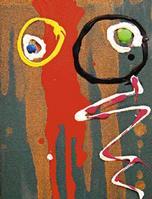
'A Tonser's Tale' - Jul. '01 (Blockhead) for Ian Dury'
Sana Rose, Contributor
'SMALL TRIBUTES' is the latest solo offering by UK-born painter Mike Stanley at Grosvenor Gallery. He has been living in Jamaica since 1988.
The show pays tribute to privately and publicly known personalities. The pieces, all done in acrylic on unprimed canvas, are consistent with Stanley's Abstract Expressionist leanings. Bright unmixed colours are poured, squeezed from paint tubes and roughly applied by palette knife or brush in a seemingly haphazard way but with colour and composition in mind.
It's the kind of work that one could easily dismiss as merely playful or childlike. The light-hearted aura and the irregular patches of complimentary colours seem to scream fun and joy. The tributes being paid are not in the form of portraits or for that matter, any recognisable object. We can make associations with the various shapes and in instances an image or two may surface from the canvas such as lips, phallic-like shapes and eyes - but for the most part, the pictures are non-representational.
Stanley's apparent automatism of tapping into the unconscious whether intentionally or not and his allegiance to the Abstract Expression-ist mode essentially focuses on form - the placement of shape, tone of colour, space, texture (implied and real) and the relationship of all these elements with each other. His theme of paying tribute seems only necessary to generate inspiration for his festival of colour.
The artist's works become a fusion of the action painting technique of American Jackson Pollock with quick flashes of colour from a brush and the poured paint method of working, championed by Morris Louis, both major artists of the Abstract Expressionist style of the 1950s. However, Stanley is not so ambitious in terms of scale for this show as these artists were. Closer to home, the bright hues of the painter's palette recalls his fellow countryman, Rex Dixon, who also sojourned here in Jamaica for many years
capturing vivid colours onto his canvases. With 'Suzi-June '86 for Suzanne Stanley' and 'Lena-Jan. '87 for Lena Horne', the somewhat Minimalist compositions hark back to the works of Jamaican painter Nicholas Morris, although the brilliant colours contrast with Morris' muted tones.
NATURE OF PAINT
The nature of paint and what it can do on the surface of the canvas is Stanley's preoccupation. The marks made in each picture are dictated by the viscosity of the paint - whether thickly applied as lines or brushed on in semi-thick layers or watery paint, which is allowed to run freely on the surface. The fact that the canvases are unprimed also affect the appearance of each mark that is made, creating a stain in some instances. These bring to the fore the importance of the immediacy of each mark. Jamaican Laura Hamilton, far more Minimalist in her approach than Stanley, also privileges the stroke or the mark on her canvases over image. In Stanley's case, the paints squeezed from tubes create line drawings, which in turn contrast with the larger and flatter areas of colour. In addition, the artist lays the colours one on top of the other and as they mix visually, their starkness affects each other in tone.
Stanley is almost totally impersonal in his approach to painting. He uses as few tools as possible to move the paint around on his canvases. As we view, we become fully aware that his pieces, although inspired by personalities, exemplify a visual language that is firmly planted within the universal ideals upon which Abstract Expressionism is based - flatness, structure and the properties of paint - in contrast to contemporary modes of artmaking which focus mainly on the subjective social, historical, political ideas, layers of meaning and a broader range of materials over paint. Stanley though, is not bothered by being considered out of sync with contemporary art as he states in his notes on painting that, "Rather than being on the 'cutting edge' of the avant-garde in art, I have always thought of myself as a 'painter', (very much as mainstream activity in art today), at the end of a line that goes back, and has something of a craft tradition." His art is built on this statement - a declaration of a formalist aesthetic. The exhibition continues until April 2.

